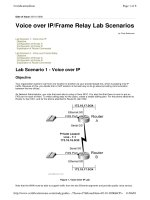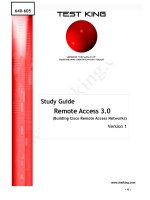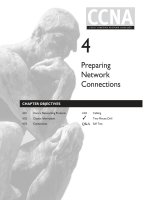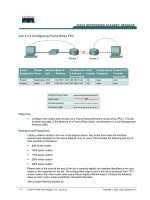Cisco Systems - Establishing frame relay connections ppt
Bạn đang xem bản rút gọn của tài liệu. Xem và tải ngay bản đầy đủ của tài liệu tại đây (741.54 KB, 22 trang )
© 2002, Cisco Systems, Inc. All rights reserved.
© 2002, Cisco Systems, Inc. All rights reserved. 2
Establishing Frame Relay
Connections
Module 8
© 2002, Cisco Systems, Inc. All rights reserved. ICND v2.0—8-3
Objectives
Upon completing this module, you will be
able to:
•
Use Cisco IOS commands to configure an operational
serial Frame Relay connection and Frame Relay
subinterfaces, given a functioning router
•
Use show commands to identify anomalies in an
operational serial Frame Relay connection and Frame
Relay subinterfaces, given a functioning router
•
Use debug commands to identify events and anomalies
in an operational serial Frame Relay connection and
Frame Relay subinterfaces, given a functioning router
and an operational serial Frame Relay connection
© 2002, Cisco Systems, Inc. All rights reserved. ICND v2.0—8-4© 2002, Cisco Systems, Inc. All rights reserved. 4
Frame Relay Overview
© 2002, Cisco Systems, Inc. All rights reserved. ICND v2.0—8-5
Objectives
Upon completing this lesson, you will be
able to:
•
Describe the features and operation of a Frame Relay network
•
Define important Frame Relay terms including local access
rate, virtual circuit, PVC, SVC, DLCI, CIR, InARP, LMI, FECN,
and BECN
© 2002, Cisco Systems, Inc. All rights reserved. ICND v2.0—8-6
Frame Relay Overview
•
Connections made by virtual circuits
•
Connection-oriented service
© 2002, Cisco Systems, Inc. All rights reserved. ICND v2.0—8-7
Frame Relay Stack
OSI Reference Model
Frame Relay
Physical
Presentation
Session
Transport
Network
Data-Link
Application
EIA/TIA-232,
EIA/TIA-449, V.35,
X.21, EIA/TIA-530
Frame Relay
IP/IPX/AppleTalk, etc.
© 2002, Cisco Systems, Inc. All rights reserved. ICND v2.0—8-8
Frame Relay Terminology
© 2002, Cisco Systems, Inc. All rights reserved. ICND v2.0—8-9
•
Frame Relay default: nonbroadcast, multiaccess (NBMA)
Selecting a Frame Relay Topology
© 2002, Cisco Systems, Inc. All rights reserved. ICND v2.0—8-10
Reachability Issues with Routing Updates
Problem:
•
Broadcast traffic must be replicated for
each active connection.
•
Split-horizon rule prevents routing updates received on
one interface from being forwarded out the same interface.
© 2002, Cisco Systems, Inc. All rights reserved. ICND v2.0—8-11
Resolving Reachability Issues
•
Split horizon can cause problems in NBMA environments.
•
Subinterfaces can resolve split horizon issues.
• Solution: A single physical interface simulates multiple logical
interfaces.
© 2002, Cisco Systems, Inc. All rights reserved. ICND v2.0—8-12
Frame Relay Address Mapping
•
Use LMI to get locally significant DLCI from the Frame Relay
switch.
•
Use Inverse ARP to map the local DLCI to the remote router’s
network layer address.
© 2002, Cisco Systems, Inc. All rights reserved. ICND v2.0—8-13
Frame Relay Signaling
•
Cisco supports three LMI standards:
–
Cisco
–
ANSI T1.617 Annex D
–
ITU-T Q.933 Annex A
© 2002, Cisco Systems, Inc. All rights reserved. ICND v2.0—8-14
Frame Relay Inverse ARP
and LMI Signaling
© 2002, Cisco Systems, Inc. All rights reserved. ICND v2.0—8-15
Stages of Inverse ARP
and LMI Operation
© 2002, Cisco Systems, Inc. All rights reserved. ICND v2.0—8-16
How Service Providers Map Frame
Relay DLCIs: Service Provider View
© 2002, Cisco Systems, Inc. All rights reserved. ICND v2.0—8-17
How Service Providers Map Frame
Relay DLCIs: Enterprise View
© 2002, Cisco Systems, Inc. All rights reserved. ICND v2.0—8-18
Service Provider
Frame Relay-to-ATM Interworking
© 2002, Cisco Systems, Inc. All rights reserved. ICND v2.0—8-19
FRF.8 Service Interworking
© 2002, Cisco Systems, Inc. All rights reserved. ICND v2.0—8-20
Summary
•
Frame Relay is an ITU-T and ANSI standard that defines
the process for sending data over a public data network.
•
The core aspects of Frame Relay function at the lower
two layers of the OSI reference model.
•
Knowing the terms that are used frequently when
discussing Frame Relay is important to understanding
the operation and configuration of Frame Relay services.
•
Frame Relay allows you to interconnect your remote sites
in a variety of topologies including star, full mesh, and
partial mesh.
•
A Frame Relay NBMA topology may cause routing update
reachability issues, which are solved by using
subinterfaces.
© 2002, Cisco Systems, Inc. All rights reserved. ICND v2.0—8-21
Summary (Cont.)
•
A Frame Relay connection requires that, on a VC, the
local DLCI be mapped to a destination network layer
address such as an IP address.
•
LMI is a signaling standard between the router and the
Frame Relay switch that is responsible for managing the
connection and maintaining status between the devices.
•
Service providers map Frame Relay DLCIs so that DLCIs
with local significance appear at each end of a Frame
Relay connection.
•
FRF.5 provides network interworking functionality that
allows Frame Relay end users to communicate over an
intermediate ATM network that supports FRF.5. FRF.8
provides service interworking functionality that allows a
Frame Relay end user to communicate with an ATM
end user.









